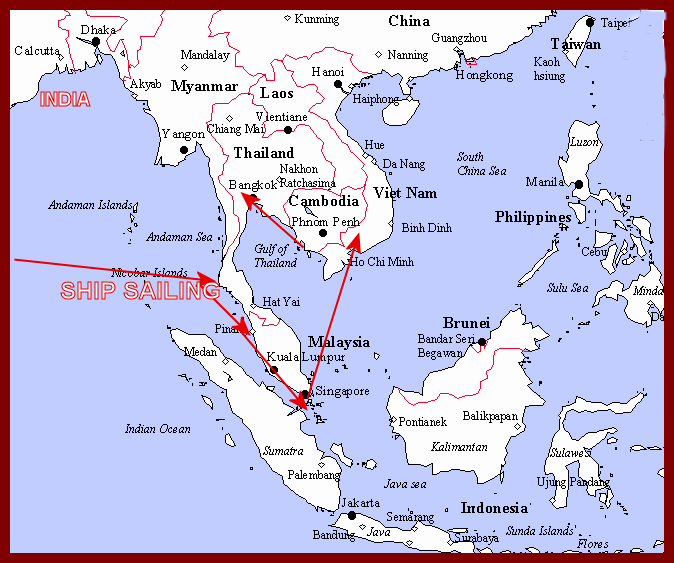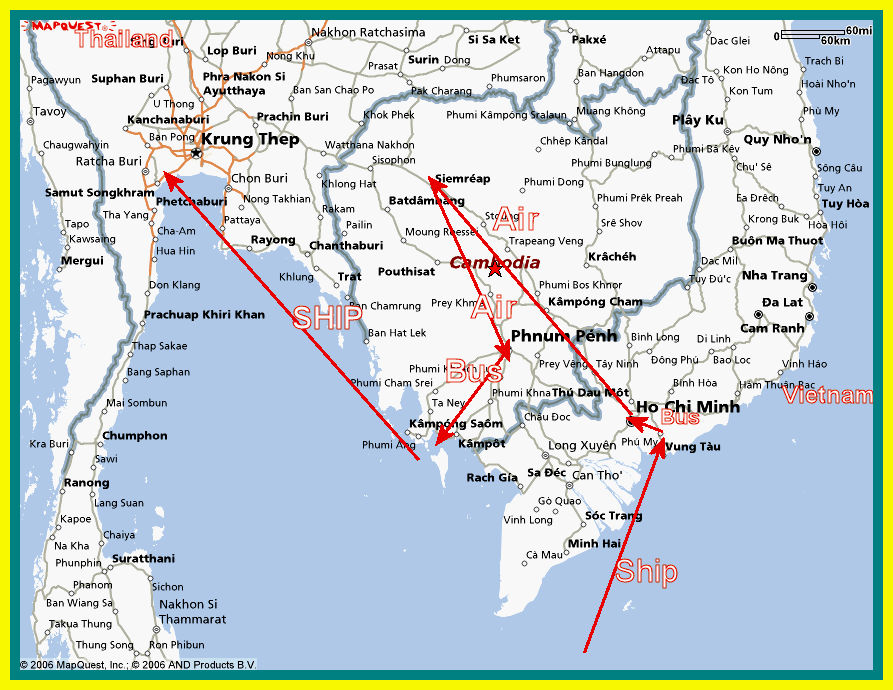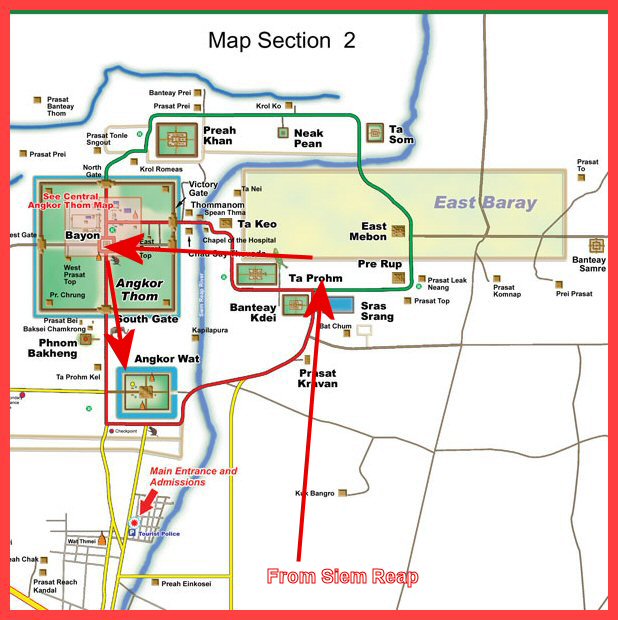"ANGKOR WAT"
.GIF) CAMBODIA
CAMBODIA.GIF)
Page Explanation
Here we have included maps of the areas visited so the reader can see exactly where we are. We found the modern history of Cambodia fascinating, and as we knew next to nothing before we left for this trip, we include here lots of historical "stuff". If this minutia is an interest to you, please help yourself to the information and the included links. If you wish to go straight to the PICTURES, scroll to the bottom of this page and select the Pictures Link....
HERE WE GO...
As can be seen from the map below, we sailed from the west (India) and stopped in Phuket, Thailand, Penang Malaysia, Kuala Lumpur, Malaysia, Singapore, and then finally to Phu My, the port for Ho Chi Minh City, Vietnam.

After arriving in Phu My, we got on a bus for the hour drive into Ho Chi Minh City (old Saigon). We had a day tour in this fascinating city and then had a 6:00 PM flight to Siem Reap, Cambodia. The next day, we spent a very exhausting 9 hours on the Angkor Wat tour. The next day we flew -- at least I think it was on a plane -- see the comments in the pictures page -- to Phnom Penh. From there we got on a bus for the 3 hour drive to Sihanoukville, the new port for Cambodia, where we rejoined the ship for the last leg to Bangkok Thailand.

SIEM REAP is the present day town that borders Angkor Wat

Located in Northwestern Cambodia, Angkor Thom, the Capital of the Ancient Khmer Empire was possibly founded around the Ninth Century AD by King Jayavarman II. However, the city reached its peak glory in the 12th Century under Kings Suryavarman II and Jayavarman VII. The most beautiful and most famous monument in the city, Angkor Wat, lies about one kilometer south of the Royal town of Angkor Thom which was founded by Jayavarman VII.

Angkor Wat is just one of a hundred or so monuments that remain scattered over an area of about 300 square kilometres in northern Cambodia - the religious remains of a series of cities, built by a succession of kings from around the 7th to the 13th centuries.
The temples of Angkor, built by the Khmer civilization between 802 and 1220 AD, represent one of humankind's most astonishing and enduring architectural achievements. From Angkor the Khmer kings ruled over a vast domain that reached from Vietnam to China to the Bay of Bengal. The structures one sees at Angkor today, more than 100 stone temples in all, are the surviving remains of a grand religious, social and administrative metropolis whose other buildings - palaces, public buildings, and houses - were built of wood and are long since decayed and gone. Conventional theories presume the lands where Angkor stands were chosen as a settlement site because of their strategic military position and agricultural potential. Alternative scholars, however, believe the geographical location of the Angkor complex and the arrangement of its temples was based on a planet-spanning sacred geography from archaic times. Using computer simulations it has been shown that the ground plan of the Angkor complex – the terrestrial placement of its principal temples - mirrors the stars in the constellation of Draco at the time of spring equinox in 10,500 BC. While the date of this astronomical alignment is far earlier than any known construction at Angkor, it appears that its purpose was to architecturally mirror the heavens in order to assist in the harmonization of the earth and the stars. Both the layout of the Angkor temples and iconographic nature of much its sculpture, particularly the asuras (‘demons’) and devas (‘deities’) are also intended to indicate the celestial phenomenon of the precession of the equinoxes and the slow transition from one astrological age to another.
Quick and Dirty Modern History Lesson on Cambodia
From 1969 until 1973, the U.S. intermittently bombed North Vietnamese sanctuaries in eastern Cambodia, killing up to 150,000 Cambodian peasants. As a result, peasants fled the countryside by the hundreds of thousands and settled in Cambodia's capital city, Phnom Penh. All of these events resulted in economic and military destabilization in Cambodia and a surge of popular support for Pol Pot. By 1975, the U.S. had withdrawn its troops from Vietnam. Cambodia's government, plagued by corruption and incompetence, also lost its American military support. Taking advantage of the opportunity, Pol Pot's Khmer Rouge army, consisting of teenage peasant guerrillas, marched into Phnom Penh and on April 17 effectively seized control of Cambodia. Once in power, Pol Pot began a radical experiment to create an agrarian utopia inspired in part by Mao Zedong's Cultural Revolution, which he had witnessed, first-hand during a visit to Communist China. Mao's "Great Leap Forward" economic program included forced evacuations of Chinese cities and the purging of "class enemies." Pol Pot would now attempt his own "Super Great Leap Forward" in Cambodia, which he renamed the Democratic Republic of Kampuchea. He began by declaring, "This is Year Zero," and that society was about to be "purified." Capitalism, Western culture, city life, religion, and all foreign influences were to be extinguished in favor of an extreme form of peasant Communism. All foreigners were thus expelled, embassies closed, and any foreign economic or medical assistance was refused. The use of foreign languages was banned. Newspapers and television stations were shut down, radios and bicycles confiscated, and mail and telephone usage curtailed. Money was forbidden. All businesses were shuttered, religion banned, education halted, health care eliminated, and parental authority revoked. Thus Cambodia was sealed off from the outside world. All of Cambodia's cities were then forcibly evacuated. At Phnom Penh, two million inhabitants were evacuated on foot into the countryside at gunpoint. As many as 20,000 died along the way. Millions of Cambodians accustomed to city life were now forced into slave labor in Pol Pot's "killing fields" where they soon began dying from overwork, malnutrition and disease, on a diet of one tin of rice (180 grams) per person every two days. Workdays in the fields began around 4 a.m. and lasted until 10 p.m., with only two rest periods allowed during the 18 hour day, all under the armed supervision of young Khmer Rouge soldiers eager to kill anyone for the slightest infraction. Starving people were forbidden to eat the fruits and rice they were harvesting. After the rice crop was harvested, Khmer Rouge trucks would arrive and confiscate the entire crop. Ten to fifteen families lived together with a chairman at the head of each group. The armed supervisors made all work decisions with no participation from the workers who were told, "Whether you live or die is not of great significance." Every tenth day was a day of rest. There were also three days off during the Khmer New Year festival. Throughout Cambodia, deadly purges were conducted to eliminate remnants of the "old society" - the educated, the wealthy, Buddhist monks, police, doctors, lawyers, teachers, and former government officials. Ex-soldiers were killed along with their wives and children. Anyone suspected of disloyalty to Pol Pot, including eventually many Khmer Rouge leaders, was shot or bludgeoned with an ax. "What is rotten must be removed," a Khmer Rouge slogan proclaimed. In the villages, unsupervised gatherings of more than two persons were forbidden. Young people were taken from their parents and placed in communals. They were later married in collective ceremonies involving hundreds of often-unwilling couples. Up to 20,000 persons were tortured into giving false confessions at Tuol Sleng, a school in Phnom Penh, which had been converted into a jail. Elsewhere, suspects were often shot on the spot before any questioning. Ethnic groups were attacked including the three largest minorities; the Vietnamese, Chinese, and Cham Muslims, along with twenty other smaller groups. Fifty percent of the estimated 425,000 Chinese living in Cambodia in 1975 perished. Khmer Rouge also forced Muslims to eat pork and shot those who refused. On December 25, 1978, Vietnam launched a full-scale invasion of Cambodia seeking to end Khmer Rouge border attacks. On January 7, 1979, Phnom Penh fell and Pol Pot was deposed. The Vietnamese then installed a puppet government consisting of Khmer Rouge defectors. Pol Pot retreated into Thailand with the remnants of his Khmer Rouge army and began a guerrilla war against a succession of Cambodian governments lasting over the next 17 years. After a series of internal power struggles in the 1990s, he finally lost control of the Khmer Rouge. In April 1998, 73-year-old Pol Pot died of an apparent heart attack following his arrest, before he could be brought to trial by an international tribunal for the events of 1975-79. |
Quick and Dirty History Lesson on Pol Pot, Leader of the Khmer Rouge
Saloth Sar or Pol Pot May 19, 1925 – April 15, 1998), better known as Pol Pot, was the ruler of the Khmer Rouge and the Prime Minister of Cambodia (officially Democratic Kampuchea during his rule) from 1976 to 1979, having been de facto leader since mid-1975. During his time in power Pol Pot instigated an aggressive policy of relocating people to the countryside in an attempt to purify the Cambodian people as a step toward a communist future. The means to this end included the extermination of intellectuals and other "bourgeois enemies". Today the excesses of his government are widely blamed for causing the deaths of up to three million Cambodians. In 1979, he led Cambodia into a disastrous war with Vietnam which led to the collapse of the Khmer Rouge government. Pol Pot is an abbreviation of the English word "Political Potential"; such is the political nickname of ex-Saloth Sar that Hanoi and China allotted to him. He was personally selected by Hanoi and China to replace Soeung Ngok Minh and Tout Sa Mut, which had just disappeared under a mysterious condition.
|
LINKS to MORE DETAILED CAMBODIAN HISTOY
NAVIGATION LINKS
 Return to INDIA PAGE
Return to INDIA PAGE